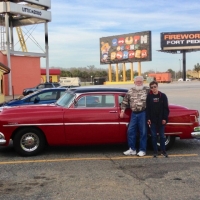12v Conversion Questions- Quick Question
Comments
-
Yes, they will require 1/2 the current at 12v which is generally better for the life of the switches

Matt0 -
Here is the diagram I made up when I redid my '64 Studebaker with an internally regulated alternator:
http://forum.studebakerdriversclub.com/showthread.php?16045-GM-Si-Alternator-Hookup&highlight=Alternator
0 -
It's internally regulated and I am replacing all the gauges and lights. There will be no stock stuff other than the ign. switch and push button.
Faustmb, what do you mean they will get 1/2 the current, I don't understand.0 -
To get the needed electrical power to do something, you can do it with high voltage and low amperage, or vice versa. It's the combo that results in electrical power, measured in watts. The move to 12v was done so as to be able to get more power in the starter and other devices while not upping the amperage from what it was with 6v. Power loss in the wires and connections is driven by the amperage flowing through them, so that's another reason for opting to go with higher voltage and lower amperage. So, the 12v devices require approximately half the amperage as their counterpart 6v dev ices did.
But note that when you keep a 6v device and drop the 12v to 6v with a resistor, that will result in the same amperage as the 6v device required on 6v.0 -
Ken, I think they must have made that change in '50 or earlier. '51s have the three terminal arrangement.0
-
Thanks for the edit, I like the blue!0
-
This '51 Comm 6 I am rewiring has a two terminal IGN switch........so unless an earlier switch was swapped in, then they were still using the two terminal, none accessory terminal switch into at least part of the 51 model year.
0 -
Interesting . . . my Hornet has the three-terminal switch, and the 1951 shop manual wiring diagram shows a three-terminal switch.0
-
My 49's all have/had one wire that connects to the battery and two connections (terminals). One for coil only and the other for all accessories . So I guess it's a three terminal switch. Of course there is no provision for an accessories only or start position. I have used Park's mod to use a GM internally regulated alternator and keep the "gen" light. Actually very simple.0
-
:-S0
-
Hey Hudsonites, in relation to switching to 12V, my new starter solenoid ST 84 comes with no marks to indicate which wires go where. Can anyone look at the pic and tell me?0
-
Trying to post pic...0
-
Interesting . . . my Hornet has the three-terminal switch, and the 1951 shop manual wiring diagram shows a three-terminal switch.0
-
David, of course the small terminal is for receiving power from the starter button when it's pushed. For the large connections, one goes to the battery and the other to the starter. Doesn't matter which goes where.0
-
Park,
I was hoping the large terminals were interchangeable. Thank you so much.
Dave0 -
Hhmmm, don't know where my reply went. Ken, its an Echlin ST84 listed in Park's 12v conversion parts list. 3 terminals, no markings. Just seemed strange, but as Park said no-brainer to hook up. Origin was mexico. No ballast resistor in my set-up as there is resistance in the coil and I'm going electronic ignition.
Dave
0
This discussion has been closed.
Categories
- 36.9K All Categories
- 112 Hudson 1916 - 1929
- 20 Upcoming Events
- 92 Essex Super 6
- 28.6K HUDSON
- 571 "How To" - Skills, mechanical and other wise
- 995 Street Rods
- 151 American Motors
- 178 The Flathead Forum
- 49 Manuals, etc,.
- 78 Hudson 8
- 44 FORUM - Instructions and Tips on using the forum
- 2.8K CLASSIFIEDS
- 608 Vehicles
- 2.1K Parts & Pieces
- 77 Literature & Memorabilia
- Hudson 1916 - 1929 Yahoo Groups Archived Photos




